Cat aggression refers to any behavior the cat displays that is intended to create a threatening situation or cause harm. It is a common problem owners face, especially if taking on a cat from a shelter or rescue. It can be directed toward people, animals, or even inanimate objects, such as toys and furniture!
Aggressive cat behavior includes hissing, biting, growling, scratching, swatting with paws, and lunging at things. There are many different kinds of aggression in cats, including petting, territorial, defensive, maternal, and inter-male aggression, all of which are distressing for owners and cats alike.
It’s essential to understand what’s making your cat behave this way so that you can help your pet, calm her, and make being around her safer and more pleasant to be around for everyone in your household.
Read this guide to learn more about the types and symptoms of cat aggression and understand how to handle that behavior safely and effectively.
What Are The Different Types Of Aggression In Cats?
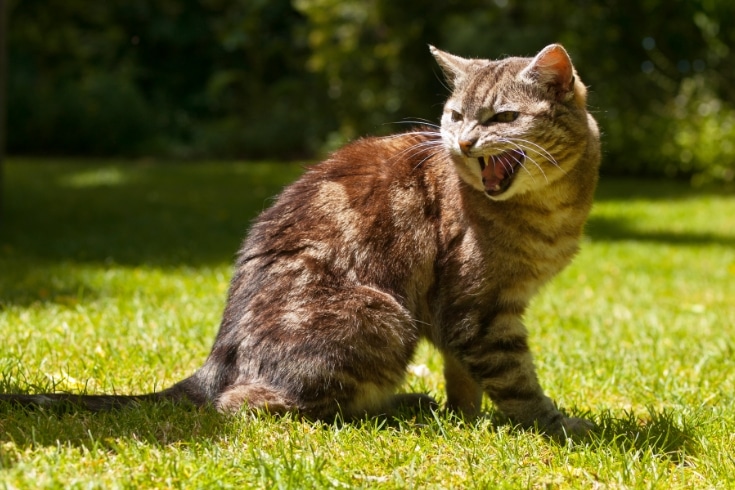
Cat aggression can be categorized into many forms, each with its own underlying causes.
Here’s an overview of the many common types of feline aggression.
Offensive Aggression
When a cat displays offensive aggression, he tries to make himself look bigger to persuade a potential attacker that he’s too tough to take on.
Defensive Aggression
In contrast, a defensively aggressive cat tries to appear smaller and less threatening in an attempt to protect himself from an attack.
Territorial Aggression
Cats are territorial creatures and can get feisty when another animal or human invades their patch and sometimes when changes are made within their familiar environment.
Fear-Induced Aggression
If a cat is anxious or afraid, he might show aggressive behavior as part of a defense mechanism. That behavior can include flattening his ears, arching his back, and even lashing out if you get too close.
Redirected Aggression
Redirected aggression happens when a cat is upset or agitated by something but redirects his aggression onto another target.
For example, when my cat is sitting on the windowsill watching the birds fluttering around in the garden, she often attacks one of her toys because she can’t reach the target of her aggression outside.
Maternal Aggression
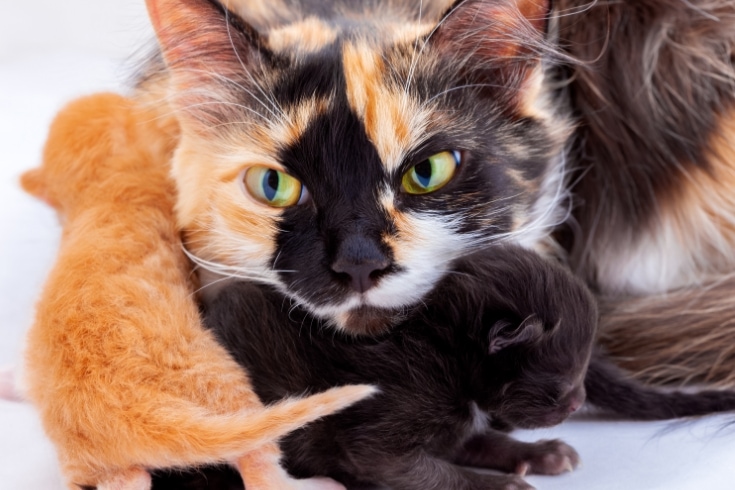
Mother cats are highly protective of their kittens and can display aggression if they think something, or someone is threatening their babies.
Play Aggression
Play aggression is often seen in young cats, especially kittens. When my two cats were babies, they would roll around on the floor together, biting and scratching, although neither was ever injured.
Although that is a natural behavior and part of a cat’s normal development, I advise you to provide a toy for your cat to play with rather than your hand!
Predatory Aggression
Most cat owners have witnessed their pets chasing birds, mice, and other small, defenseless creatures outside in the backyard. Cats, by nature, are predatory hunters that will catch and kill small prey animals if given the chance. Again, that’s a perfectly natural, albeit rather undesirable, behavior that we cat owners simply have to tolerate.
Inter-male Aggression
When male cats reach two to four years of age and reach sexual maturity, it’s not uncommon for them to display aggression toward other male cats.
Sexual hormones are typically a major contributor to this type of aggression, and neutering your cat is often highly effective in improving the situation.
Pain-Induced Aggression
Most animals can become aggressive when in pain, generally because they feel vulnerable and weakened, and it’s just their way of protecting themselves from further pain.
So, if your cat suddenly becomes aggressive for no apparent reason, I recommend you seek veterinary advice just in case your pet has an undetected medical condition that is causing discomfort.
Idiopathic Aggression
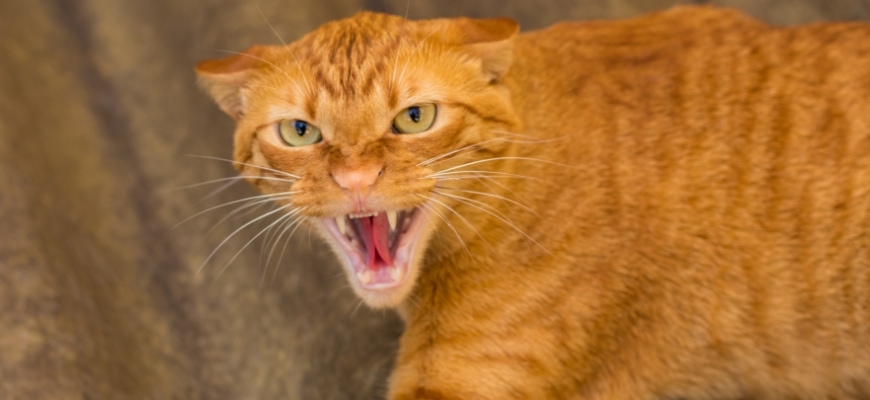
Idiopathic aggression refers to any form of aggression that cannot be explained or determined through a medical examination or the cat’s behavioral history.
A cat displaying this type of aggression can attack its owner violently, repeatedly biting, scratching, and remaining upset for long periods of time.
Social Aggression
Cat social aggression happens between cats in a social context, including an interaction between unfamiliar felines, establishing the pecking order within a multi-cat household, and competing for resources.
Status-Related Aggression
Sometimes, if a cat wants to establish social dominance, it will demonstrate status-related aggression.
For example, if your cat obstructs a doorway with his body and swipes at your other cat as it passes, that demonstrates status aggression.
Petting-Induced Aggression
Even though your cat might appear to enjoy being petted, she could become aggressive if overstimulated, and you must get to know the signs that mean enough is enough!
Learned Aggression
Learned aggression in cats is the term used to refer to aggressive behavior that cats develop because of past experiences and learned associations and can relate to other animals, people, and even their immediate environment.
What Are The Causes Of Cat Aggression?
The causes of aggression in cats are many and varied but generally include the following:
Medical Problems or Pain
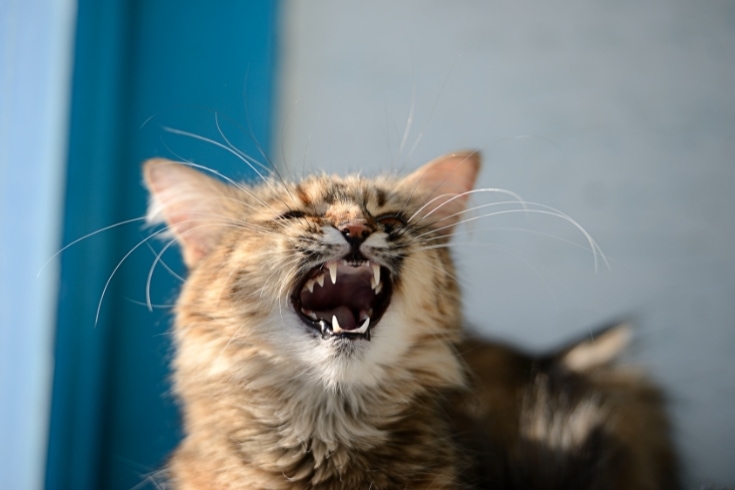
As previously mentioned, if a cat is in pain or has medical problems that leave the animal feeling weak and vulnerable, it can become aggressive when handled.
Fear or Anxiety
Cats can become aggressive as a defense mechanism when they are afraid or anxious. Again, that’s just a natural reaction and doesn’t mean the cat hates your vet!
Territorial Disputes
Cats are territorial animals that protect their home patch against perceived intruders, such as a neighbor’s cat and even a stranger visiting your house.
Mating Behavior or Competition
Cats can become quite aggressive when in competition for mates or resources, such as food. That sometimes leads to squabbles at meal times and if an unneutered cat encounters a female in season.
Socialization Issues
Cats that are not used to being handled and petted can display aggression in social situations. The same goes for indoor cats that are kept in isolation and have never been exposed to other cats.
Trauma or Negative Experiences
If your cat has experienced trauma or bad handling in the past, she will find it difficult to adjust to life in a more settled, peaceful environment.
I once took on a stray cat from a shelter that became very aggressive when I put her in her travel crate for routine vet visits. Although it wasn’t clear why that was, I suspect the cat had been caged in a former life and was terrified that the same would happen to her again.
Frustration
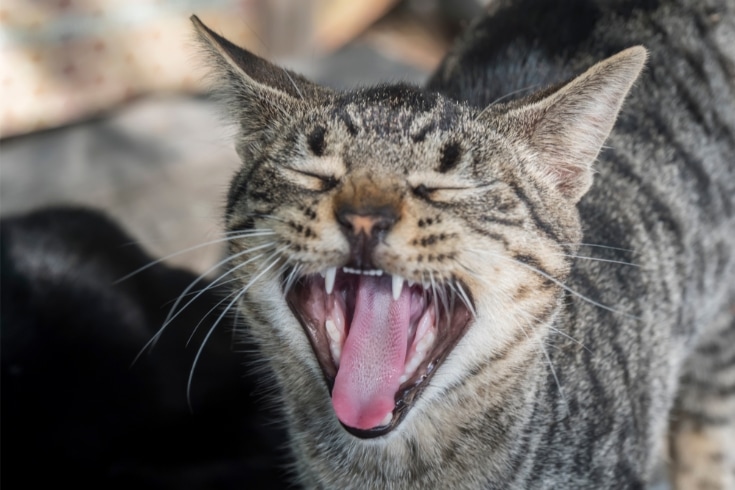
If a cat is frustrated by a lack of attention, displays of aggression can result. A work colleague told me that her cat would jump onto the sofa and bite her head if she ignored it!
Rough Play
Young cats and kittens tend to play rough, and that can result in displays of aggression.
Environmental Changes
As mentioned earlier, cats are territorial, so a change in their environment can lead to insecurity that sometimes manifests itself as aggression.
Changes In The Family Or Home Dynamics
Bringing a new pet or baby into your home can upset the cat’s feeling of security, leading to aggressive behavior until things settle down again.
Introduction Of New Pets
Often, bringing a new pet into the home can trigger aggression in the family cat. When I bought my new puppy home, one of my cats started hissing and swatting at the little guy until she realized her new canine companion wouldn’t hurt her.
Misdirected Aggression
If a cat is excited by a stimulus but can’t respond directly, it might redirect its aggression toward another cat, human, or object.
Predator-Prey Instincts
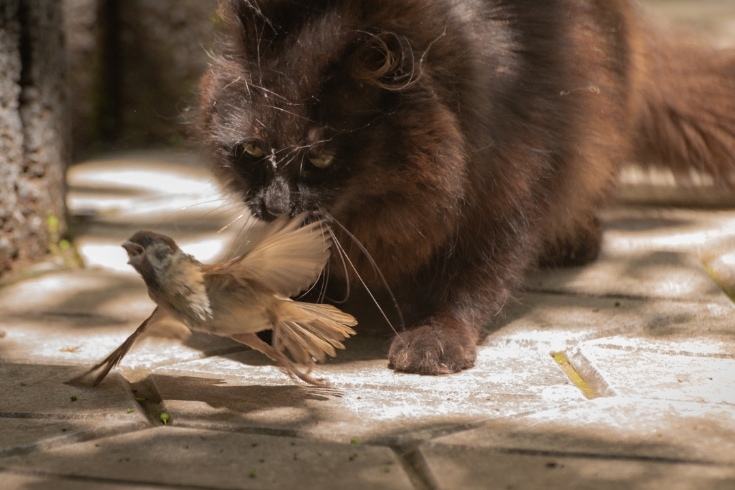
Cats are natural predators, and outbursts of aggression can occur when a cat spots a mouse or bird that it sees as prey.
Resource Guarding
Although canines are more prone to resource guarding than felines, it’s not unheard of for a cat to defend a bowl of food from another pet in the home or even from you.
High-Prey Drive
Some cats have a very high prey drive that causes them to chase anything small or slow enough to catch, including other pets and even kids!
Age-related Cognitive Decline
Cats can suffer from dementia in a similar way to humans, especially as they age and their overall health deteriorates. I once had an elderly cat that began to show minor aggressive behavior as her eyesight failed and she developed cognitive decline symptoms.
Hormonal Imbalances
A male cat can often become bossy and aggressive as he approaches sexual maturity due to hormonal changes. Some medical conditions, such as hyperthyroidism, can also cause hormonal imbalances and consequent aggression, although those can generally be managed through drug therapy.
Breed-specific Predispositions
Some cat breeds are said to be more aggressive than others, such as Siamese, Bengal, and Egyptian Mau. However, that’s not to say that every one of those cats is aggressive, and much depends on how well the kittens are socialized and raised.
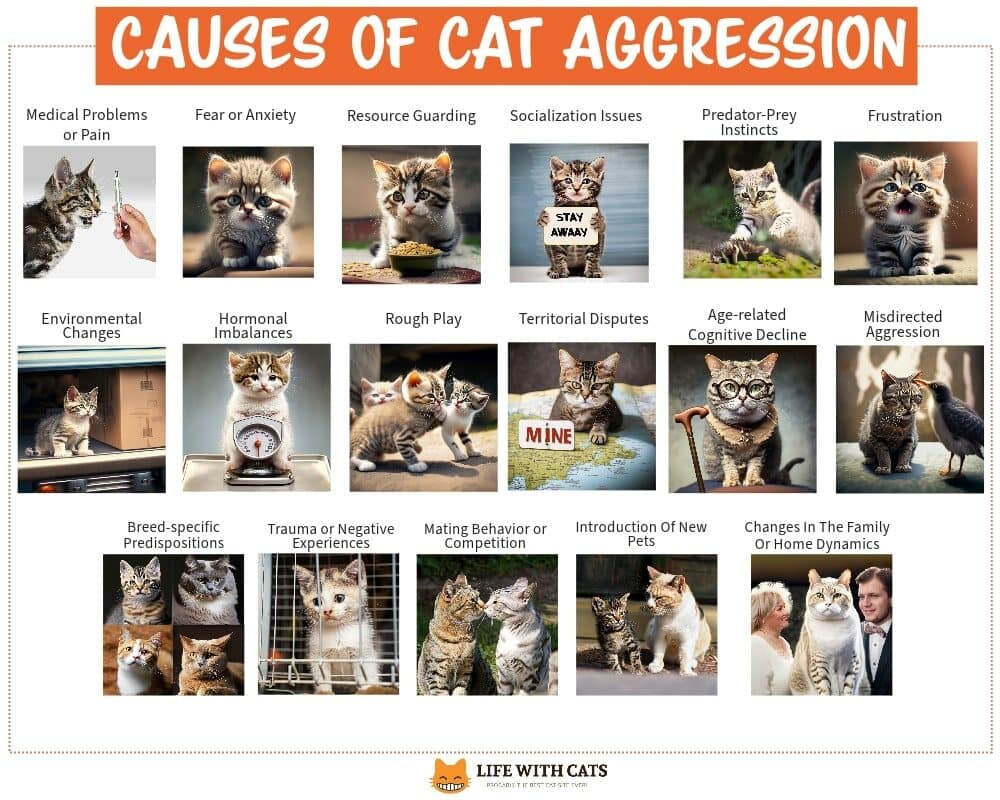
What Are The Signs and Symptoms of Cat Aggression?
The signs and symptoms of cat aggression are many and varied, but you need to know how to recognize them to stay safe around your feline friends.
Body Language
Cats are big on body language, and it’s amazing how a change in posture can be a sure sign that trouble is brewing in kitty’s world.
Arched Back
The witch’s cat look is a prime indicator that your cat is feeling feisty, although that can sometimes be part of play behavior.
Fluffed Tail and Piloerection (Raised Fur)
Cats fluff out their tail and raise their fur to make themselves look bigger and more scary than they actually are. That’s usually successful in putting off a potential opponent and averting the need for a physical fight.
Dilated Pupils
Your cat’s eyes can tell you much about your pet’s mood. Dilated pupils usually indicate anxiety, fear, or aggression and can be an early warning sign that your cat is not happy.
Ears Flattened Against the Head
When your cat flattens her ears against her head in what’s commonly called “airplane mode,” that usually means the cat is afraid or nervous and could potentially lead to aggressive behavior.
When your cat’s ears are flat against its head, the cat is telling you that she is uncomfortable and needs some space.
Direct stare
When your cat stares at you directly, that generally means she is frightened. Approach your cat slowly, and talk to her calmly and gently so that you don’t inadvertently trigger an aggressive response.
Vocal Cues
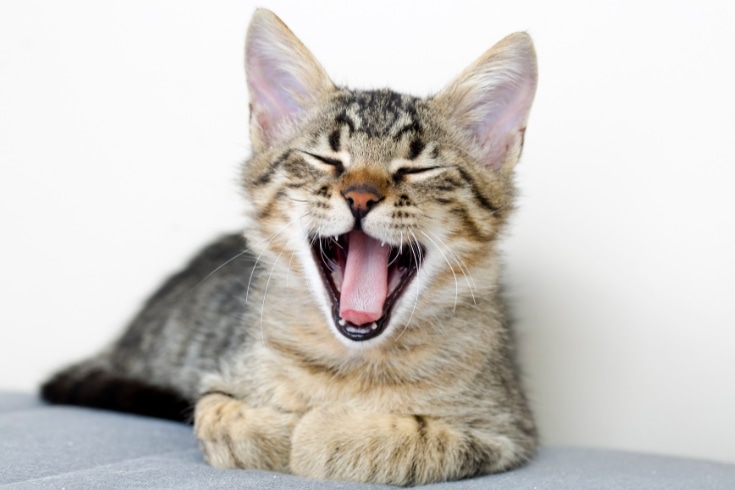
Vocal cues of aggression to watch out for can include hissing, growling, or yowling.
Hissing, Growling, or Yowling
If your cat starts hissing, growling, or yowling, that’s a vocal cue that your cat is getting angsty with you or with another cat.
Physical Contact
Physical contact that can indicate aggression includes:
Swatting or striking out with paws
Your cat might strike out or try to swat you or another pet with her paws as a sign of aggression.
Biting or scratching
If your cat scratches you or bites you, that’s a sign of aggression.
Blocking pathways or exits
Some cats try to assert their dominance by blocking a doorway to stop you or another pet from entering or exiting the room. That can also be a sign of mild aggressive behavior.
Aggressive body posturing
If the cat arches its back or flattens its ears when you or another animal approaches, that’s an indicator of aggressive behavior.
Lunging forward or chasing
Chasing or lunging forward is usually any aggressive behavior that’s reserved for another cat or animal.
Sudden Mood Changes
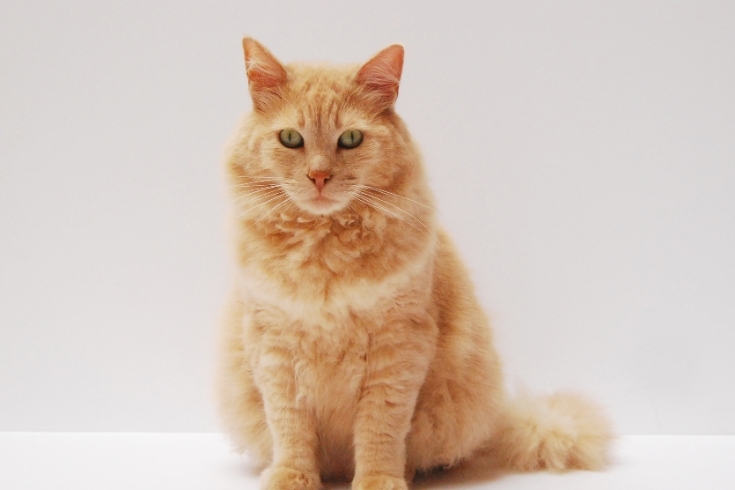
In cases where the cat has some kind of physical or mental problem, you might see sudden mood changes that result in aggressive behavior, including unprovoked attacks, isolation and avoidance, and stalking you or other family members.
Chemical Cues
Sometimes, cats use scents to show aggression by warning other cats to keep away.
Marking Territory Aggressively
A more subtle sign of aggression in cats is excessive territory marking. Male cats can spray at particular spots around your garden to tell your cats that there’s another feline on the block.
Signs of Defensive vs. Offensive Aggression in Cats
As you know, cats display both offensive and defensive aggression, and understanding how to recognize those behaviors in your cat will help you interpret them better.
Defensive Aggression
A defensively aggressive cat will try to make itself look smaller by crouching with its tail close to its body and sometimes flattening its ears against its head and arching its back.
Defensive cats often growl or hiss as a warning not to get too much closer, and defensive behaviors like scratching or biting can also be seen during play sessions when one or both cats become over-stimulated.
A defensive cat will usually try to run away from a stressful situation or hide underneath a table or chair in an attempt to find a safe spot.
Offensive Aggression
Unlike defensive cats, offensive aggressors generally have their ears pointing forward and try to make themselves appear larger. These cats might stalk their target, leopard-crawling across the ground stealthily while maintaining direct eye contact with their target in preparation for a physical attack.
Offensive aggression is often accompanied by yowling or growling, and if an attack does happen, an offensive cat will typically pounce on the target, biting and scratching.
It’s important to note that individual cats often exhibit both offensive and defensive aggressive behaviors, depending on the circumstances.
What Is The Impact of Aggression On A Cat’s Health and Well-Being?
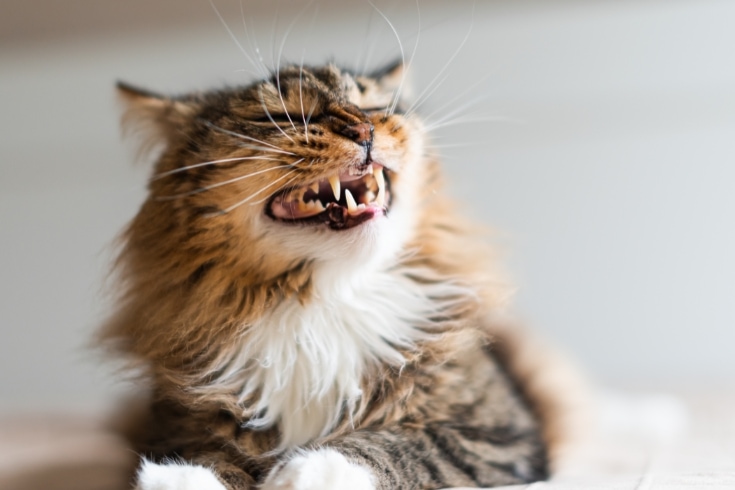
Aggression in cats may lead to the following health and well-being problems.
Increased stress and anxiety levels
If your cat is aggressive, she will become stressed and anxious rather than calm and relaxed.
Potential for self-inflicted injuries
An aggressive cat can sometimes get injured when trying to attack you or another pet, especially if cornered.
Reduced social interactions
Aggressive cats tend to keep themselves to themselves, so they miss out on valuable social interactions with people and other cats. For example, I once owned a rescue cat who preferred to stay away from me rather than let me pet her.
Increased risk of obesity due to inactivity
Aggressive cats that hide away from the company of others can easily become overweight due to their inactivity, potentially causing health problems, especially in senior cats.
Lower quality of life
If a cat is constantly on the defensive or becomes aggressive when other cats or people come too close, she will miss out on affection, company, comfort, and even food, leading to a lower quality of life.
Increased risk of abandonment or rehoming
No one wants to take home an aggressive cat that tries to bite or scratch them and can’t get along with kids or existing family pets. So, these are the cats that are most likely to be dumped or put up for rehoming.
Development of behavior-related health issues (e.g., over-grooming, feline lower urinary tract disease)
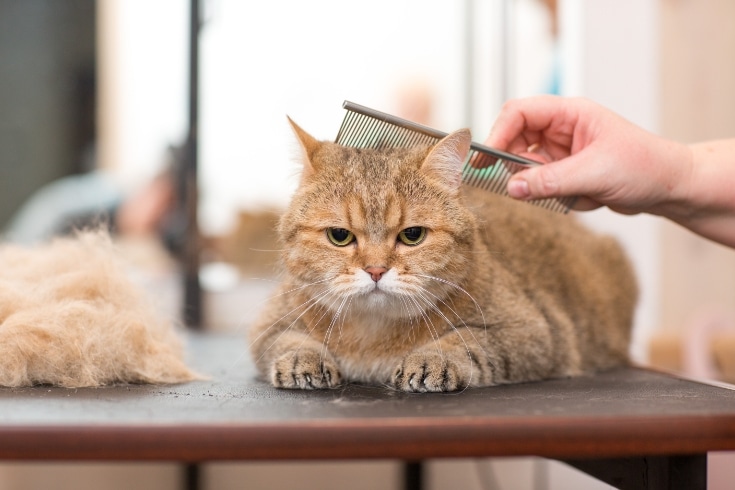
The stress brought about by aggressive behavior can lead to other behavioral issues, such as overgrooming, and even leads to more serious health conditions, such as FLUTD or Feline Lower Urinary Tract Disease.
Disruption in sleep patterns
An aggressive cat generally finds it difficult to settle down and sleep soundly because her mindset is always in “fight or flight” mode.
Changes in eating habits
Cats that suffer from chronic aggression often become fearful or anxious, leading to a reduced appetite and weight loss, and the lack of adequate nutrition can cause other health problems, too.
Higher susceptibility to illnesses due to chronic stress
The stress of living with chronic aggression contributes to many health problems in cats, such as digestive issues, skin allergies, and even respiratory tract problems.
Strained relationships with owners and other pets
Clearly, a bad-tempered kitty is not conducive to creating a relaxed environment in your home and usually leads to a strained relationship between the cat and your other pets.
Potential for harm to others (humans, other animals)
An aggressive cat can bite or scratch you and your other pets, leading to nasty, potentially serious injuries.
Behavioral issues could lead to reduced veterinary care
Persuading an aggressive cat to sit quietly in a cat carrier en route to the vet can be stressful for all parties concerned, and the prospect of your cat attempting to savage the vet during a routine examination is not a prospect that any owner welcomes.
So, some owners decide not to seek veterinary advice when their cat is sick.
That said, you should never be afraid to take your cat to the vet! Vets are trained and equipped to handle difficult animals, so always seek veterinary advice, even if you have a feisty feline!
The stigma attached to “aggressive” breeds or behaviors can limit adoption opportunities.

Some cat breeds have a reputation for aggression, and that stigma can lead to those felines being overlooked by potential adopters at shelters and rescues.
However, if a cat has been properly socialized and any behavioral issues overcome, there’s no reason why a cat of any breed can’t make a loving, happy family pet.
How Is Cat Aggression Diagnosed?
Aggression in cats is diagnosed by some or all of the following strategies.
Complete Medical History Review
In cases of sudden-onset cat aggression, your first action should be to consult your vet who will take a complete medical history review.
Physical Examination
Your vet will carry out a physical examination of your cat to determine if your cat has any physical conditions that might be causing pain, resulting in aggression,
Behavioral Observation And Analysis
If the medical examination doesn’t reveal an obvious cause for the cat’s aggression, your pet might be referred to a veterinary cat behaviorist for further evaluation.
Detailed Owner Interview Regarding Cat’s Behavior
The behaviorist will interview you regarding your cat’s current behavior.
Laboratory Tests (Blood Tests, Urinalysis)
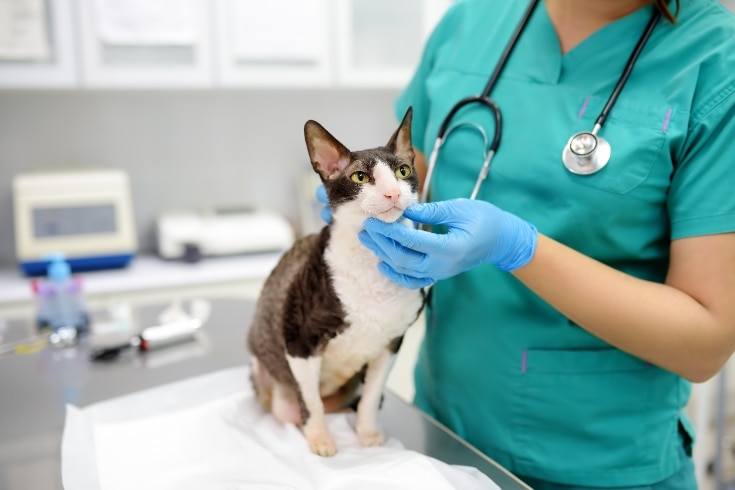
Part of the veterinary examination could include lab tests, including urinalysis and blood tests to diagnose any underlying health conditions that could be affecting your cat’s behavior.
Pain Assessment
As previously mentioned, pain can cause a previously calm cat to become aggressive, so your vet will carry out a pain assessment to determine if your cat is feeling any discomfort that could be causing the behavior.
Neurological Examination
A neurological examination can sometimes determine if the cat has a nerve problem somewhere that could be causing her pain, resulting in aggressive behavior.
Specific Aggression Tests (If Applicable)
An animal behaviorist could carry out specific aggression tests to try to establish the trigger for your cat’s aggressive behavior.
Imaging (X-Rays, Ultrasound, MRI)
As part of the veterinary examination, your vet might carry out imaging, i.e., X-Rays, ultrasound, or MRI scans, to try to find the cause of your cat’s pain or weird behavior.
Referral To A Veterinary Behaviorist For Further Evaluation
If the physical examination doesn’t reveal a likely cause of your cat’s aggression, your vet might refer your pet to a veterinary behaviorist for further evaluation.
Cognitive Function Assessment (For Older Cats)
Sometimes, older cats can suffer from a form of feline dementia, which can affect their temperament, so your vet might carry out a cognitive function assessment if you own a senior furry friend.
Hormone Level Tests (If Suspected)
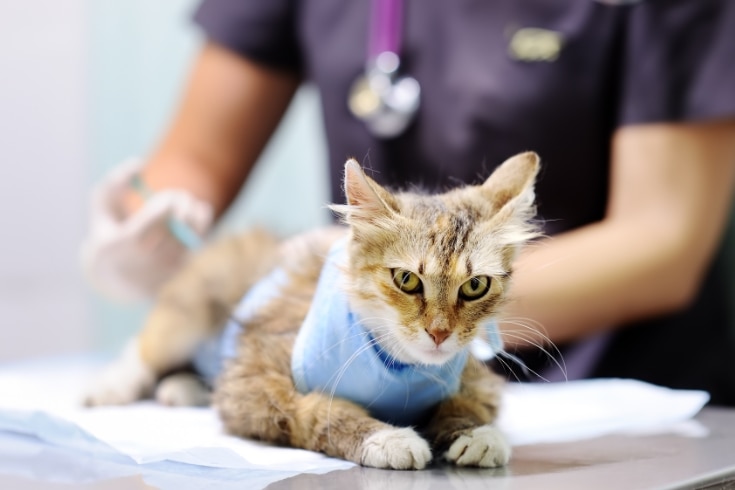
Aggressive behavior can be linked to hormone imbalances, so your vet might decide to carry out hormone levels tests to see if your pet’s hormone levels are out of whack. That can also identify underlying, undiagnosed health problems, such as hyperthyroidism, which can usually be managed through drug therapy.
Allergy Testing (If Suspected)
Cats can suffer from allergies to various things, including certain foods. If your vet thinks your cat is allergic to something in her home environment, allergy testing might be carried out.
Review Of Environmental Factors And Stimuli
An animal behaviorist will usually thoroughly review your cat’s environment to determine if there’s anything there that could be triggering your cat’s aggression.
Assessment Of Cat’s Socialization And Past Experiences
Often, what’s happened to shelter and rescue cats before being rehomed can heavily influence their behavior and temperament, so part of the animal behaviorist’s review will include an assessment of your pet’s socialization and past experiences.
What Are The Treatment Options For Aggressive Cats?
The treatment options for cat aggression largely depend on what’s causing the aggression, but they can include the following options:
Behavioral Modification Therapy
Various behavior modification therapies can be used to modify cat behavior, including extinction, desensitization, habituation, counterconditioning, shaping, and response substitution.
Environmental Changes
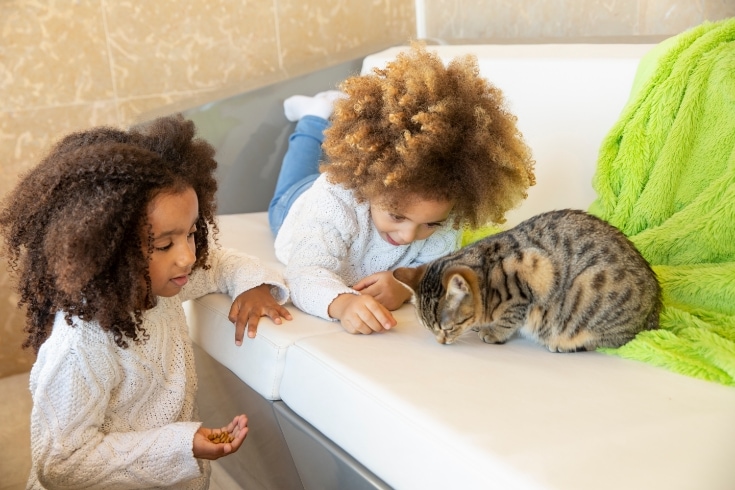
If your cat’s aggressive behavior is linked to her environment, you might be advised to make changes to your pet’s living conditions.
Socialization Training
Aggressive behavior often occurs because a cat has not been socialized as a kitten or in her formative years, so socialization training is sometimes recommended.
Use Of Pheromone Diffusers Or Sprays
Pheromone diffusers or sprays can be highly effective in calming your cat and reducing her aggressive tendencies.
Medication (Anti-Anxiety, Antidepressants)
In extreme cases, your vet might prescribe drug therapy, including anti-anxiety or antidepressant medication, for your feisty feline.
Play Therapy
When your cat’s prey drive triggers aggression or because your pet is bored, some forms of play can provide an outlet, making your cat calmer.
Positive Reinforcement Techniques
As explained earlier, positive reinforcement techniques involve rewarding your cat for showing good behavior and can effectively reduce aggression.
Habituation And Counterconditioning Techniques
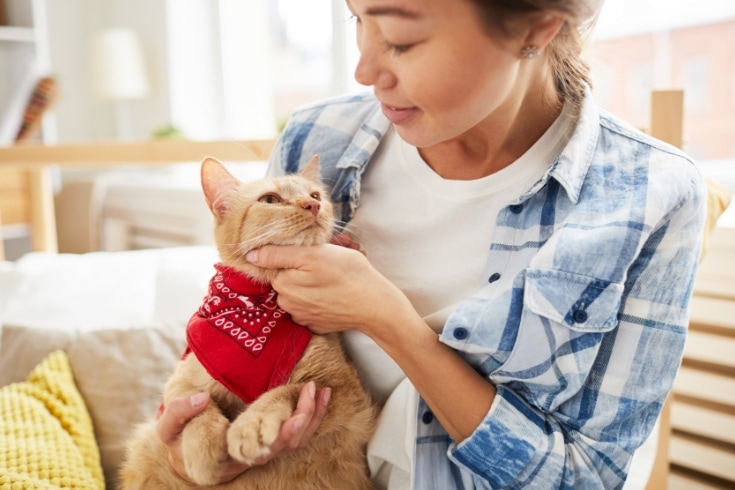
These behavior modification techniques can help to reduce aggression in cats.
Desensitization Exercises
As mentioned earlier, desensitization behavior modification techniques can help reduce cat aggression.
Use Of Calming Products (Toys, Bedding, Etc.)
Sometimes, providing an interactive toy or a comfortable, cozy bed can give your cat what she needs to feel more relaxed and calm.
Dietary Changes
If your cat’s diet is causing allergies and aggression, changing things up can work wonders!
Pain Management (If Pain-Induced Aggression)
Pain management therapy, including medication, can work well if your cat’s aggression is triggered by pain.
Regular Exercise And Stimulation
Sometimes, lack of exercise and boredom can lead to frustration and aggression in cats. So, providing more exercise and mental stimulation can be effective.
Cognitive Therapy (For Older Cats)
Senior cats can benefit from cognitive therapy, although that doesn’t always work without drug intervention, too.
Surgical Intervention (In Some Cases, e.g., Hormone-Related Aggression)
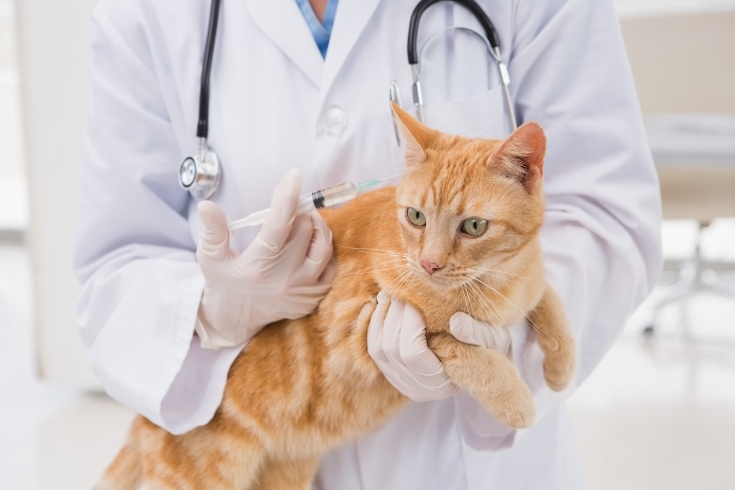
In extreme cases, surgical intervention can help to calm your cat, although, these days, certain hormone-producing glands are generally managed through drug therapy rather than surgery.
Consultation With A Veterinary Behaviorist
As mentioned already, your vet might recommend consulting a veterinary behaviorist to address your cat’s aggressive behavior.
Aggression-Specific Training Programs
Many of those options involve consulting your vet or an expert cat behaviorist. However, there are some techniques for managing an aggressive cat that you can try at home.
What Are The Tips For Managing An Aggressive Cat At Home?
Cat aggression can be managed at home by using one or more of the following strategies, depending on what’s making your cat behave aggressively.
Avoid Direct Confrontation Or Punishment
When your cat behaves aggressively, don’t confront her or punish her.
Provide Safe Spaces For The Cat
If your cat’s aggression is caused because she feels insecure, ensure you provide plenty of safe, secure, dark places where your pet can hide and chill out.
Keep A Consistent Daily Routine
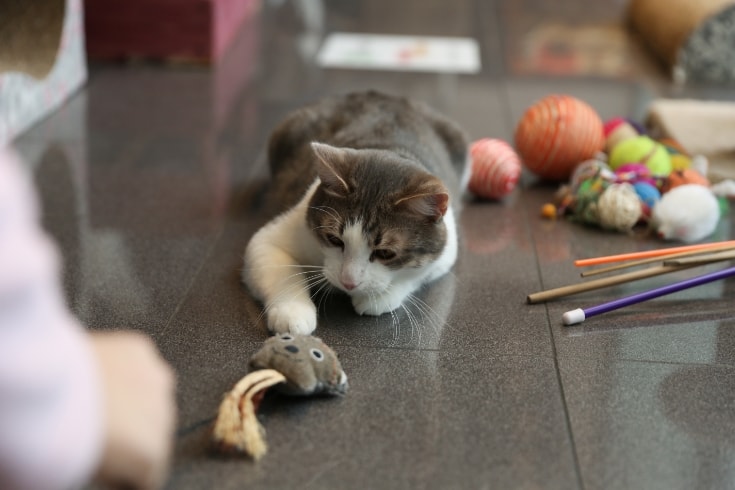
Cats are creatures of routine, and knowing when it’s feeding time, playtime, and time to go outside can help to moderate cat aggression.
Use Positive Reinforcement Methods
As explained earlier, positive reinforcement techniques involve rewarding your cat for showing good behavior and can effectively reduce aggression.
Engage In Regular Interactive Play
Taking time out to play with your cat daily can help burn off her excess energy, leaving your pet tired and mentally relaxed.
Introduce New Pets Or People Gradually
Sometimes, introducing a new pet or person to the household can leave your cat feeling threatened and insecure, so be sure to introduce new pets or people gradually and singly to give your cat a chance to adjust to the new home dynamic.
Maintain A Calm, Quiet Home Environment
Maintain a calm, quiet home environment to help your cat chill out and reduce stress-related aggressive outbursts.
Utilize Interactive Toys To Redirect Aggression
Use interactive toys, such as cat teasers, to redirect your cat’s aggression away from other pets and people in your home.
Use Pheromone Products For Calming Effects
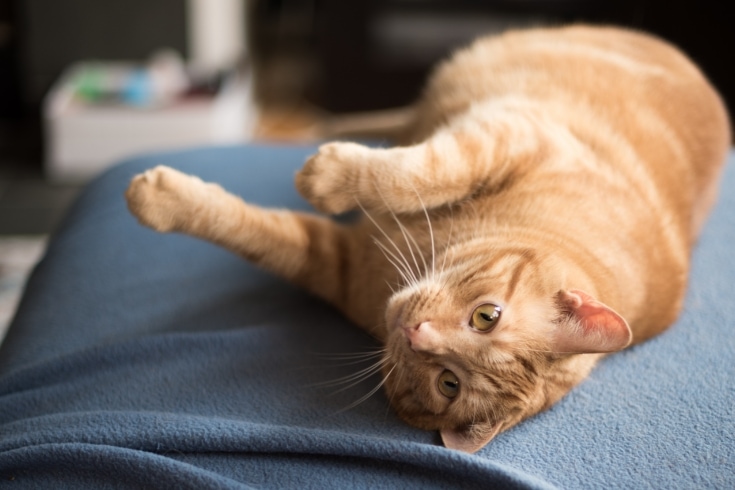
As mentioned earlier, pheromone products can help to calm your pet and reduce aggressive behavior, so use plug-ins or sprays around your home.
Avoid Touching Sensitive Areas (Unless Necessary For Grooming Or Medical Reasons)
Unless you have to groom a long-haired cat to prevent mats or for medical reasons, be careful not to touch your cat in areas she finds sensitive.
Learn To Read Your Cat’s Body Language
Learn to understand and read your cat’s body language so that you can anticipate her aggressive outbursts and take steps to moderate them.
Do Not Disturb The Cat When It Is Sleeping Or Eating
Aggression in cats can be triggered when the cat is startled or disturbed when asleep or eating, so be sure to leave your cat in peace at these times.
Provide Plenty Of Resources (Litter Boxes, Feeding Stations) To Reduce Competition
In a multi-cat household, ensure you provide plenty of resources, such as litter boxes, feeding stations, toys, and the like to reduce competition between the cats.
Consult A Professional Behaviorist For Serious Aggression Problems
If your cat has serious aggressive behavioral problems, don’t struggle alone; always consult a professional behaviorist for help and advice.
Practice Gentle Handling Techniques
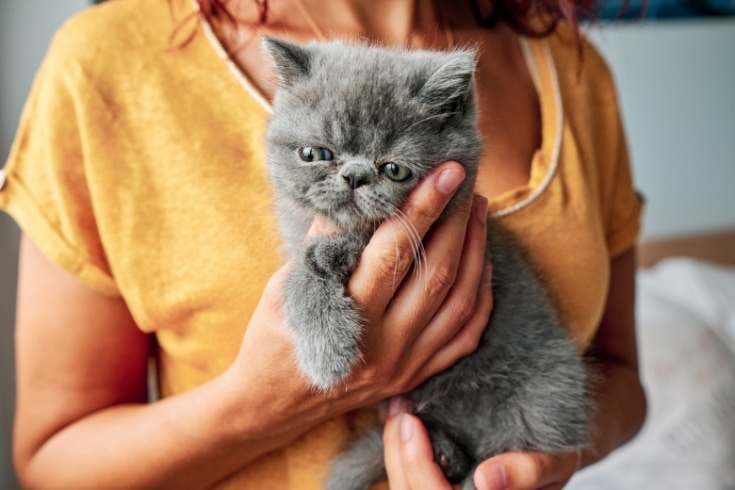
Be very gentle whenever you need to handle your cat to avoid triggering aggression.
Socialize Kittens At An Early Age
If you bring home a kitten, be sure to socialize her well with other cats, people, and other stimuli she’s likely to encounter in her environment.
Consider Medication As A Last Resort, With Veterinary Consultation
If you’re still struggling with your cat’s aggressive behavior, you might want to consider asking your vet if there’s a suitable drug therapy that might help your pet but that should only be as a last resort when all other tactics have failed.
What Are Preventative Strategies For Cat Aggression?
Cat aggression can be prevented by trying the following tips:
Early Socialization And Exposure To Various Stimuli
Early socialization and exposure to various stimuli are especially important for kittens and young adult cats. Positive experiences at a very young age can build a firm behavioral foundation for the future, helping to prevent problems with aggression from developing later in the cat’s life.
Regular Veterinary Check-Ups
Cats are excellent at hiding health problems, so regular veterinary check-ups can prevent undetected conditions from causing your cat discomfort and pain that could lead to aggressive behavior.
Providing A Stimulating Environment (Toys, Perches, Scratching Posts)
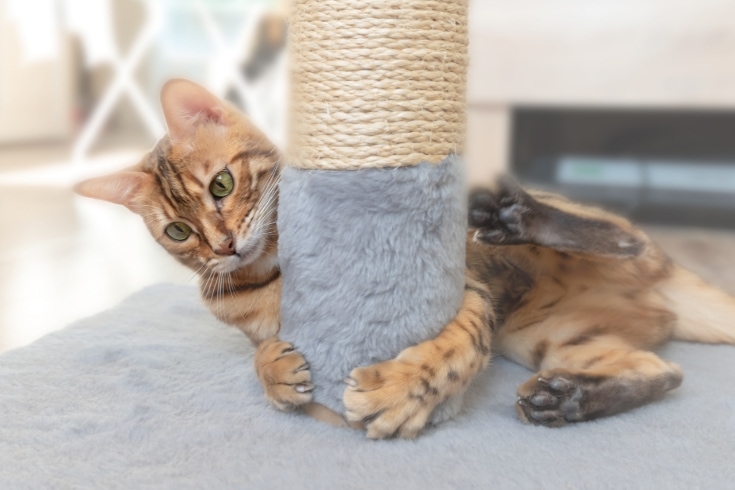
Providing a stimulating, enriched environment, including toys, perches, and scratching posts, helps to keep your cat physically fit and mentally happy, preventing boredom-related aggression.
Adequate Physical Exercise And Mental Stimulation
Ensure that your cat gets enough exercise and mental stimulation through playtimes or trips outside if appropriate.
Positive Reinforcement Training
Use positive reinforcement training to help keep your cat mentally relaxed and teach her that good behavior earns her a reward.
Appropriate Introduction Of New Pets Or People
As previously mentioned, the appropriate introduction of new pets or people is essential. Gradually introduce newbies to the household so that your cat doesn’t feel threatened or pushed out.
Avoiding Stress-Inducing Situations Or Triggers
Observe your cat to learn what stress-inducing situations or triggers cause her to become aggressive and work to avoid them.
Offering Multiple Resources (Food, Water, Litter Boxes) To Avoid Competition,
Prevent competition in multi-cat households by offering multiple resources, such as food, water, litter boxes, etc.
Understanding And Respecting The Cat’s Body Language
Understanding and respecting the cat’s body language enables you to avoid creating or exacerbating situations where aggressive behavior could result.
Ensuring The Cat Has A Safe Place To Retreat To
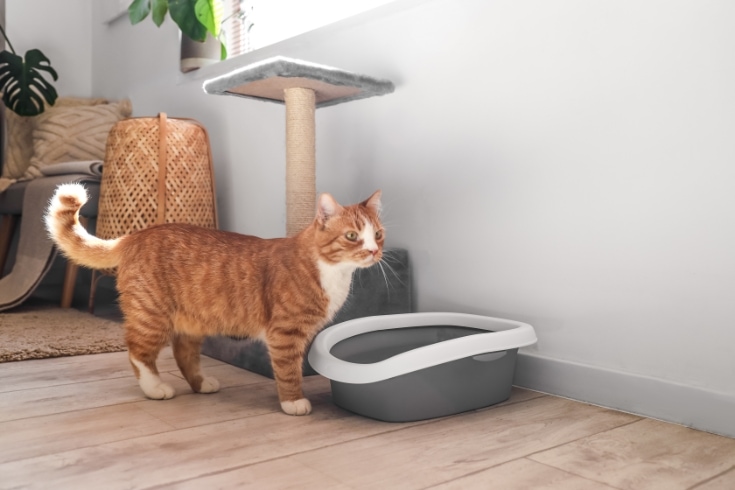
Ensuring the cat has a safe place to retreat to when she wants some peace and quiet goes a long way toward preventing frustration, anxiety, and aggression.
Consistent Daily Routines
Consistent daily routines make your cat feel more secure and safe, so be sure to set a routine for your cat and stick to it!
Regular, Balanced Diet To Maintain Health
A regular, balanced diet helps maintain good health and vitality; if your cat feels good, she is less likely to become aggressive.
Spaying Or Neutering To Reduce Hormonal Aggression
Spaying or neutering can reduce hormonal aggression and prevent unwanted kittens. I recommend having your cats de-sexed as soon as they’re old enough and before problems with wandering and aggression start.
In fact, in the UK, the Cats Protection charity makes it a condition of ownership that you have their kittens de-sexed before they’re allowed outside to prevent straying and unwanted pregnancies. All their adult cats are spayed or neutered before being offered for adoption.
Promptly Addressing Any Behavioral Changes With Professional Guidance
Promptly addressing any behavioral changes with professional guidance can help to fix aggressive behaviors before they become entrenched.
Use Of Calming Aids Or Pheromone Products As Needed
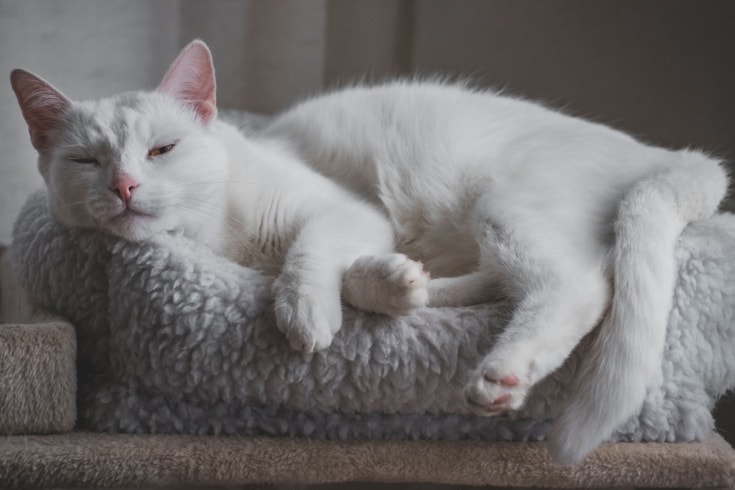
The use of calming aids or pheromone products as needed can be very effective, although not all cats respond to them.
When dealing with an aggressive cat, there’s often no one-size-fits-all solution, so you might need to use a combination of the above approaches to help your pet and fix the problem.
Always be ready to seek professional help and advice from a cat behaviorist or your vet if the problem worsens or your efforts go nowhere.
FAQs
Here are the answers to some of the most frequently asked questions about aggression in cats.
Are Certain Cat Breeds More Aggressive?
Certain cat breeds are reputedly more aggressive than others. For example, Siamese and Bengal breeds can be more feisty than Rag Dolls and Maine Coons.
Why Is My Cat Suddenly Aggressive?
There are many reasons why your cat might suddenly become aggressive, although the most likely is a change in your household demographic, such as a new puppy or kitten or some kind of medical condition affecting your pet.
Why Is My Cat Aggressive at Night?
There are several reasons why a cat might get aggressive at night. Your cat might be hungry and want to eat; she could be feeling playful or have a medical problem that means she’s in pain or feels uncomfortable.
What Not to Do With Aggressive Cats
Do not try to console or comfort an aggressive cat, as that could be seen as approval of the aggressive behavior.
In addition, you should not show fear or retreat from a display of aggression, as that might encourage the cat to continue threatening you if she wants you to back down. The best way to handle aggression is to ignore the cat and not give it any attention.
Is It Normal For Cats To Be Aggressive?
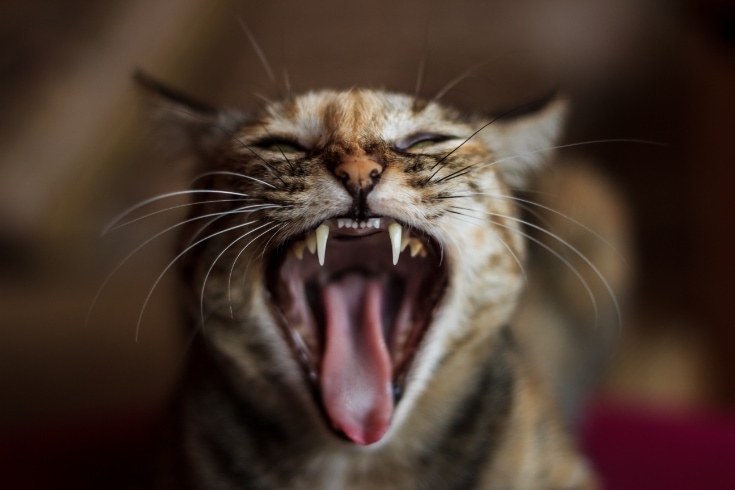
Cat aggression is pretty normal behavior under certain circumstances. For example, it’s perfectly normal for cats to play fight or chase prey.
However, if your cat is very aggressive when being petted or approached by your kids, that’s not normal cat behavior and must be investigated.
Can Aggressive Cats Be Fixed?
Sometimes, you can fix cat aggression by using medication in combination with environmental modification and behavioral training.
Does Cat Aggression Go Away?
Cat aggression doesn’t generally just go away on its own without some kind of intervention. However, kittens and young cats often grow out of aggressive play fighting, and having your cats de-sexed can help.
Why Is My Cat Attacking My Other Cat?
Cats in a multi-cat household can show aggression for different reasons, such as resource guarding, mating behavior, jealousy, and territoriality if a new cat is introduced to your home.
How Long Does Cat Aggression Last?
Cat aggression usually lasts for a couple of hours before things calm down. Don’t try to interfere during that time, or you could be injured.
Will Catnip Calm An Aggressive Cat?
According to research, catnip works on certain receptors in the cat’s brain that induce feelings of happiness. Initially, you’ll see your cat getting excited and perhaps charging around the room, until she ultimately relaxes and becomes calm.
Do Cats Become Less Aggressive With Age?
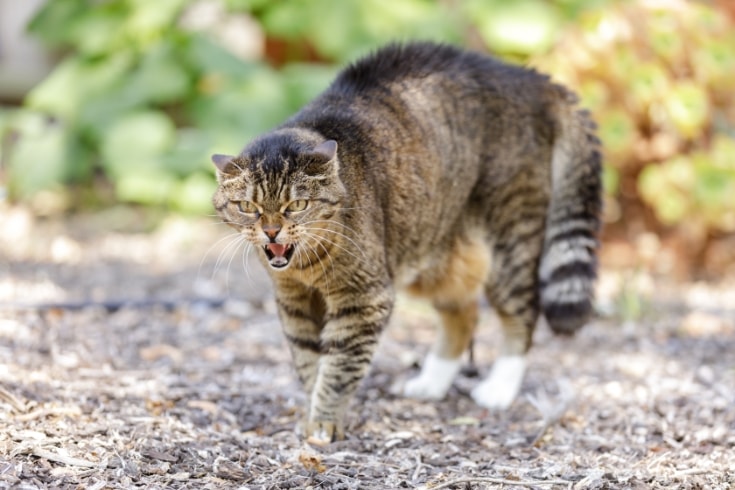
Unfortunately, cats tend to become more aggressive as they approach their latter years, often because of the pain of conditions such as arthritis and dementia.
Is Aggression Genetic In Cats?
Since wild cats are relatively small compared to other animals, they are vulnerable to attack by predators. That’s why your domesticated house cat is genetically programmed to use aggression to defend herself against perceived threats.
Should You Ignore An Aggressive Cat?
In many cases of cat aggression, it’s best to ignore that behavior. However, if the cat is physically attacking you or another of your pets, the best action to take is to make a loud noise, such as clapping your hands, to startle the cat and diffuse the immediate situation.
Does Anxiety Make Cats Aggressive?
Sometimes, an anxious cat can become aggressive, depending on what’s stressing her out. For example, if your cat is upset because you’ve recently moved home, she might get feisty with her new feline neighbors, although that behavior usually settles down after a few weeks.
In Conclusion
I hope you enjoyed our guide to aggression in cats, recognizing the signs, and managing the problem. If you did, please remember to hit the share button before you go!
Cats have sharp teeth and claws and can inflict nasty injuries to other pets and to you! To make your home a happy, harmonious, and safe environment for everyone in your household to live in, you need to nip cat aggression in the bud quickly and effectively.
Your cat could be aggressive for a wide range of reasons, including fear, poor socialization, the introduction of a new pet to your home, territorial behavior, and during overenthusiastic play.
Once you’ve identified what’s making your cat behave aggressively, you can help her behave more appropriately by using one of the methods outlined above.
If you’re struggling to fix your cat’s aggressive behavior, always seek professional advice from your vet or an animal behaviorist.
How did you help your cat to become less aggressive? Tell us in the comments box below!